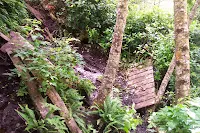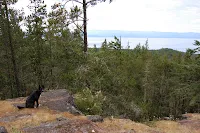Based on conversations with Tarptent owners on the TLB Forums I decided to go with the Double Rainbow. I wanted a 2-person, lightweight shelter that could be set up with minimal amount of staking. The Double Rainbow fits the bill perfectly, as it is free-standing (with the use of two trekking poles) or can be staked out for more versatility.
The included instructions were a little bit confusing to start with, but in the end the setup was fast and straight forward. One long shock-corded pole is threaded through a sleeve, and inserted into a grommet at each end. The poles then sit on top of the extended trekking poles that lie horizontally on the ground, and are secured in place by velcro tabs. Four cords are then attached to the ends of the poles to secure the floor, completing the setup. In ideal conditions this should only take 2 or 3 minutes, but I can see needing two people and a bit of fiddling in windy/rainy conditions.
I was expecting to feel more exposed inside, considering this is a "tarp tent" rather than a tent, but the name is deceiving. The entire exterior can be pulled down and secured, resulting in a seemingly bombproof enclosure, but with a quick reconfigure can be ventilated, opened up to create "beaks" or vestibules, and an array of other configurations to suit the terrain and conditions.
Of course, the best part about the Double Rainbow is the weight. 2.5 pounds for a two-man shelter is fantastic! My current tent, the MEC Merganser, with groundsheet, comes closer to 8 pounds, so this is a significant reduction. This means my hiking partner and I can each lower our pack weights by nearly 3 pounds.
My next trip is the West Coast Trail in August, and I'm a bit apprehensive of taking the Tarptent into such wet, rugged conditions on its first outing. I had hoped to get it last weekend when I did a one-nighter on the Juan de Fuca Marine Trail with my brother, but unfortunately Canada Customs decided they needed 9 days (and $11.27) to determine that the tent wasn't made from cocaine. Perhaps some backyard camping with the sprinkler on will serve as a test. Stay tuned for updates!






